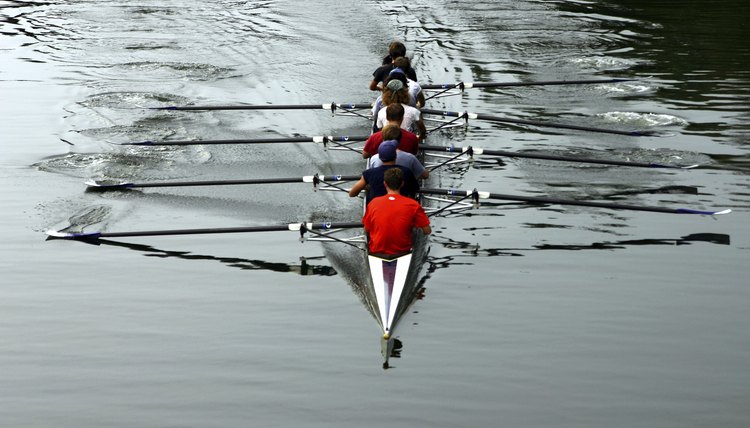Difference Between Heavyweight & Lightweight Rowing

Heavyweight, or open, rowing is not defined by weight. Bigger and stronger athletes are welcome in the heavyweight class. Lightweight rowing, on the other hand, is limited to those who are small enough to make weight. At the international and college level, a male rower is not eligible to compete in lightweight rowing if he weighs over 160 lbs. A woman cannot row in the lightweight division if she is over 130 lbs.
Rationale
While a good lightweight rowing team can sometimes beat a heavyweight team, the sport of rowing favors the tall and strong athlete. Height gives a rower more leverage to propel the boat through the water. Strength gives a rower the explosive power to propel the boat faster. According to the Federation Internationale des Societies d' Aviron, or FISA, the international governing body of the sport, lightweight race was introduced "to encourage more universality in the sport, especially among nations with less statuesque people." Lightweight events were introduced at the World Championships in 1974 for men and 1985 for women, and it joined the roster of events at the Olympic Games in 1996.
FISA Support
Because of the initiative of FISA to expand rowing into countries that traditionally lack rowing programs, especially in Asia and Latin America, where the people are generally smaller, lightweight rowing has gained popularity in some places. For example, competitive rowing in Japan has become increasingly popular, and the size of the Japanese people steer most rowers toward lightweight racing.
College Rowing
Lightweight rowing, particularly lightweight rowing for women gets the short end of the stick in the United States, the rowing coach at William & Mary wrote back in 1998. The situation is more dire in 2011, and the future doesn't look any brighter. Many high school and college rowing programs have dropped lightweight rowing altogether. While an open team is theoretically open to all girls and women, most girls and women who want to row won't be big or strong enough to compete for a spot in the boat. And with budget pressures on college athletics as of the date of publication, lightweight rowing is even less likely to receive funding and recognition.
Issues
The practice at some colleges of using heavyweight rowers to drop sufficient pounds to qualify for the lightweight boat is controversial on two grounds. First, drop-down rowers replace "normal" lightweights in the boat, cutting opportunities for smaller rowers to compete. Second, allegations of eating disorders among both women rowers and male drop-downs have been widespread. A female college rower at the Everything 2 website tells of men "living on carrots and multivitamins for weeks while doing full workouts every day," in a misplaced attempt to demonstrate discipline toward their sport.
Olympic Events
There are six Olympic events for men in the heavyweight or open category as of 2012 -- single sculls, double sculls, quadruple, pairs, fours, and eight with coxswaim. There are two lightweight events for men: the lightweight doubles and the lightweight four. The women's events mostly mirror the men's events, although there is only one lightweight event for women: the lightweight double.
References
Writer Bio
Jim Thomas has been a freelance writer since 1978. He wrote a book about professional golfers and has written magazine articles about sports, politics, legal issues, travel and business for national and Northwest publications. He received a Juris Doctor from Duke Law School and a Bachelor of Science in political science from Whitman College.
